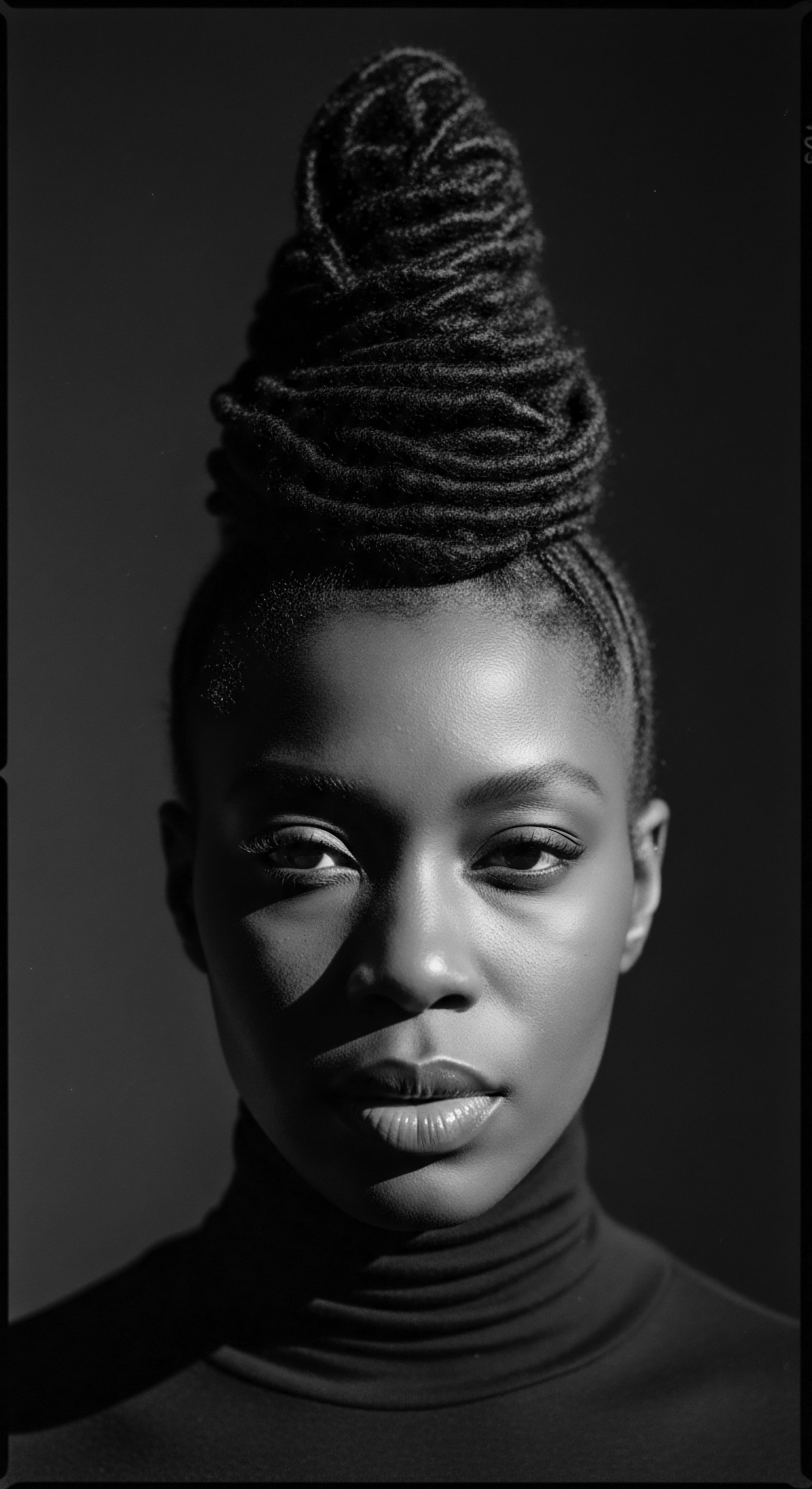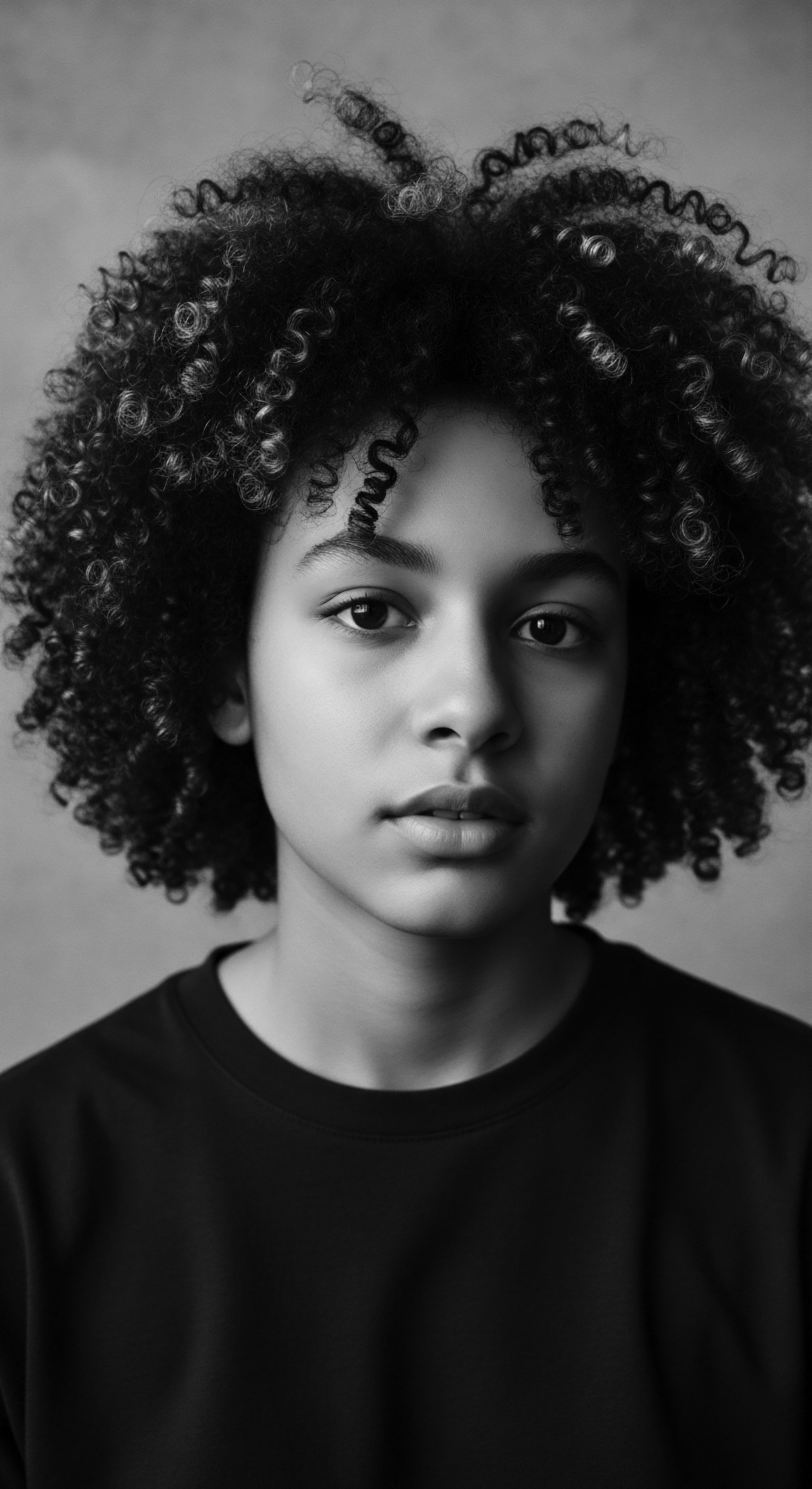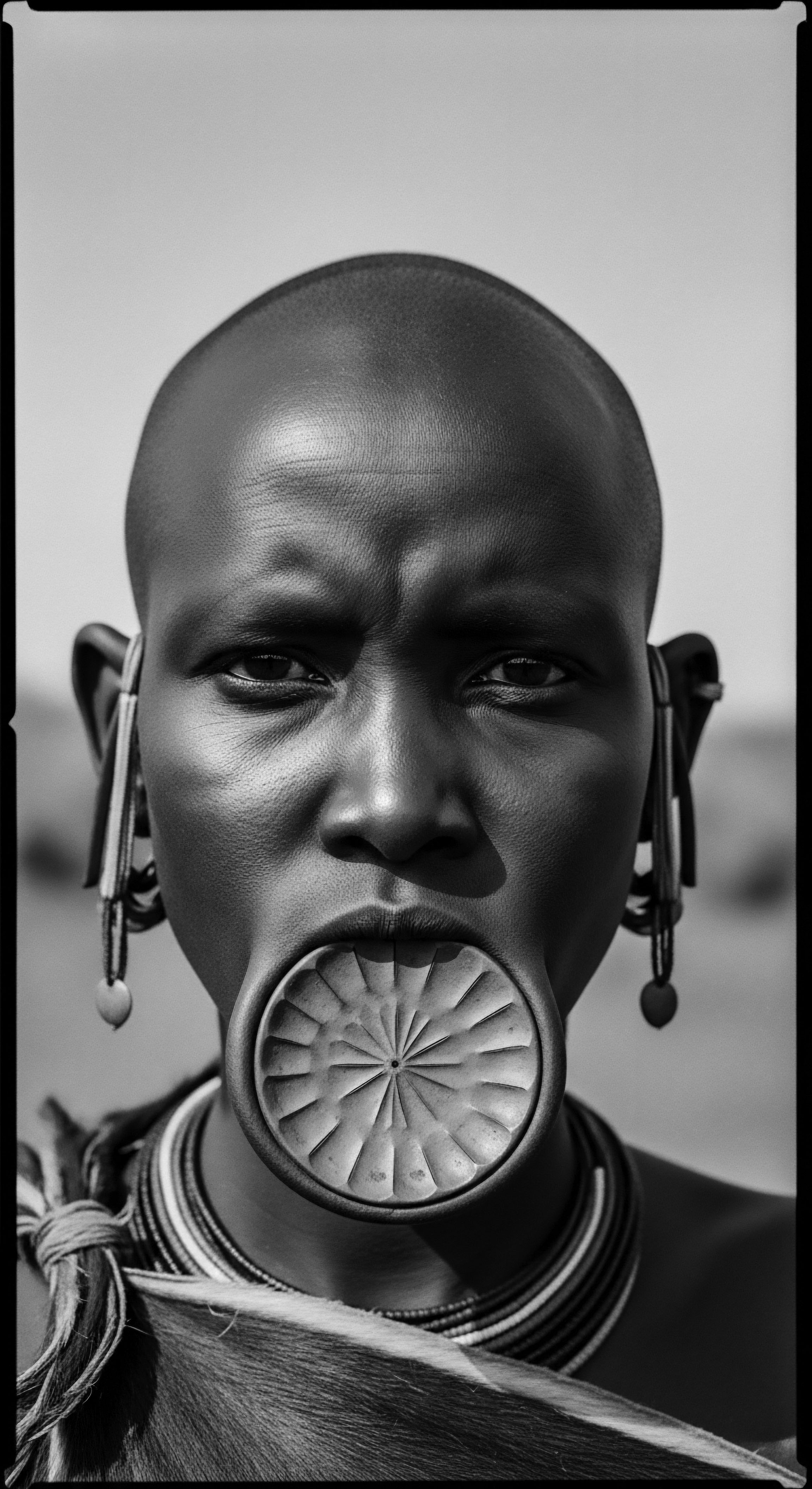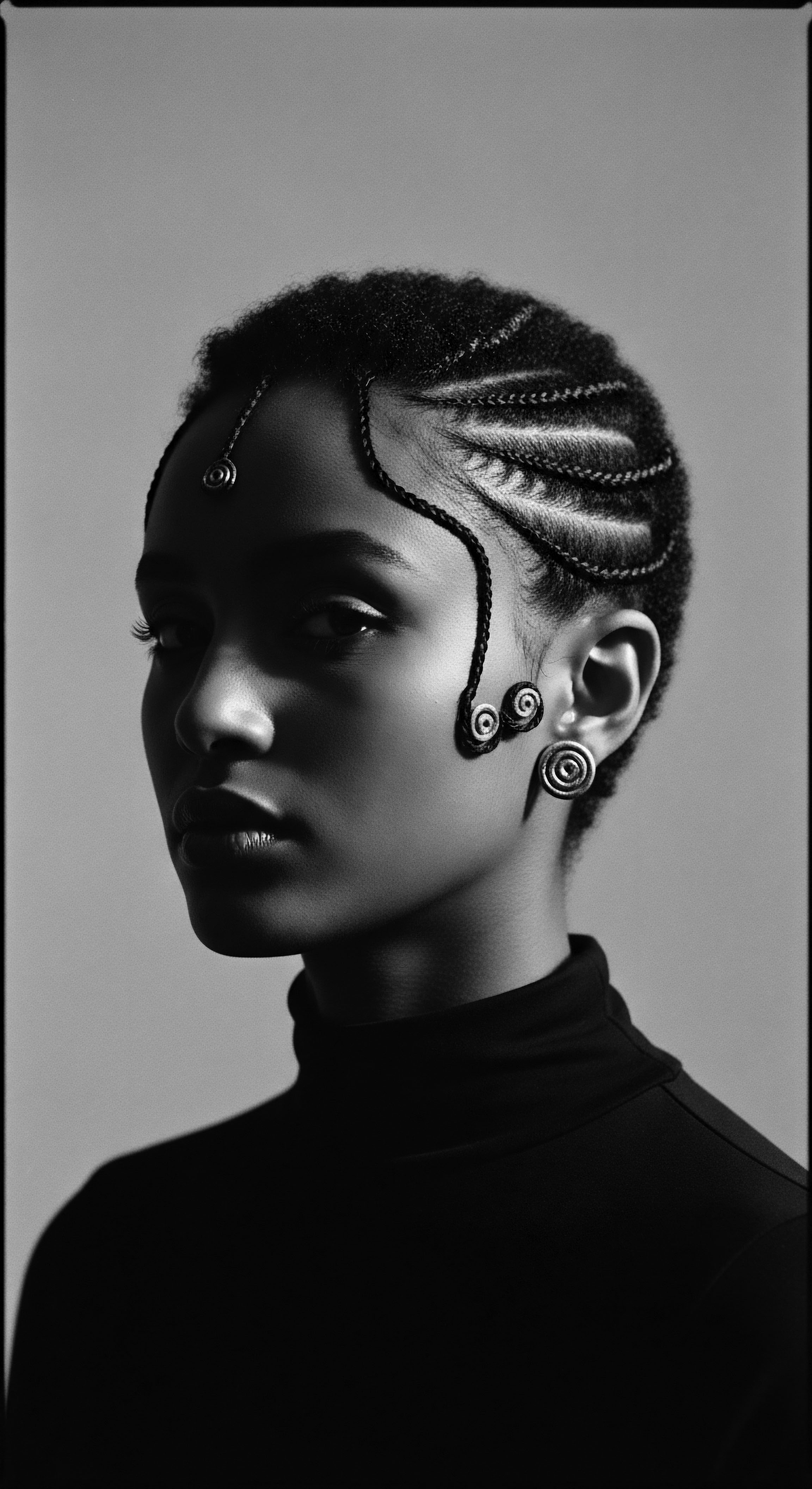
Fundamentals
The cowrie, a shell of oceanic origin, extends far beyond its material form; it embodies a profound cultural language, especially within the context of textured hair heritage. Across continents and through generations, this seemingly modest shell has served as a powerful signifier, a conduit for narratives about identity, ancestry, and well-being. Its designation in various traditions often highlights its dual existence as both a natural artifact and a carrier of immense symbolic weight. The very appearance of the shell, with its protective, smooth exterior and the inviting, elongated aperture, has inspired countless interpretations, each resonating with ancestral wisdom concerning the body, spirit, and community.
For communities that have long revered their hair as an extension of self and spirit, the cowrie’s presence often marks a dialogue between the physical and the metaphysical. It becomes a tactile representation of shared histories, resilience, and the continuity of knowledge passed down through the ages. The explication of its meaning starts with understanding its biological origins—the marine gastropod—and then moves outward to the intricate layers of human significance placed upon it. From adornment to sacred object, the cowrie has participated in rituals, commerce, and personal expression, always maintaining a connection to a deeper, more enduring cultural framework.
The cowrie shell, more than an adornment, serves as a powerful cultural language, deeply interwoven with the heritage and spiritual narratives of textured hair traditions.
The cowrie’s role in hair heritage can be considered a testament to ancient connections that transcend geographical boundaries. When considering its cultural symbolism in the context of hair, one must look to its earliest applications. Before its widespread use as currency, the shell held ceremonial value, often associated with life-giving forces and the protection of new growth.
This protective aspect naturally extended to hair, particularly for those with hair textures that demanded intricate care and held deep ceremonial significance. The shell’s shape, sometimes likened to an eye or a vulva, lent itself to interpretations connected to vision, rebirth, and feminine power.

Ancestral Echoes in Adornment
The earliest interpretations of cowrie shells saw them as natural amulets. They were worn not simply for visual appeal but for the presumed spiritual properties they conferred upon the wearer. In many ancient societies, hair was regarded as a spiritual antenna, a direct link to the divine and to ancestral realms.
Placing cowrie shells within hair, therefore, was a conscious act of inviting protection, fostering fertility, or expressing spiritual allegiance. This practice speaks to a reverence for both the natural world and the unseen forces that guide human existence.
Consider the simplest form of cowrie application in hair ❉ a single shell, often braided into a lock or strand. This seemingly small gesture carried a significant weight, a statement of identity and belief. It might have signified a blessing, a prayer for prosperity, or a visible acknowledgment of one’s lineage. The specific placement and number of shells could further refine these meanings, acting as a visual lexicon for those who understood its silent dialogue.
- Protection ❉ Cowries were often thought to ward off malevolent spirits or ill fortune, safeguarding the hair—and thereby the individual—from harm.
- Fertility ❉ Given their resemblance to the female reproductive organ, cowries frequently symbolized abundance, birth, and the continuity of life, relevant for those seeking to promote hair growth or family lineage.
- Prosperity ❉ As a form of currency, cowries naturally came to denote wealth and economic well-being, worn as a display of social standing.
- Spiritual Connection ❉ In numerous belief systems, the shells acted as conduits to deities or ancestors, particularly when integrated into sacred hairstyles.

Intermediate
Moving beyond its elemental presence, the Cowrie Cultural Symbolism, in the realm of textured hair, assumes a richer, more stratified meaning. It becomes a testament to complex societal structures, spiritual philosophies, and the nuanced interplay between aesthetics and belief. The interpretation shifts from basic understanding to a comprehensive appreciation of its deployment within specific cultural matrices, particularly among communities of African descent. Here, the shell’s significance expands to encapsulate notions of social standing, ceremonial roles, and a profound connection to the metaphysical landscape that shapes daily existence.
The cowrie’s journey from a humble shell to a potent cultural emblem is tied directly to its historical circulation as a form of currency across vast trade networks. This economic function elevated its status, rendering it a tangible representation of value, exchange, and accumulation. For individuals, particularly those with textured hair, adorning oneself with cowries became a display of success, a visual declaration of one’s place within the communal hierarchy. Yet, this monetary sense was often intertwined with older, spiritual significations, where wealth was not merely material but also spiritual, measured by one’s connection to ancestors and cosmic forces.

Social Stratification and Identity Markers
Within many West African societies, the manner in which cowries were integrated into hairstyles could indicate a person’s age, marital status, or even their profession. Elaborate cowrie-adorned braids or coiffures were often reserved for chiefs, priests, or esteemed elders, broadcasting their authority and wisdom. For younger individuals, simpler arrangements might denote readiness for marriage or a specific stage of initiation. The specific patterns of cowrie placement, the type of hair manipulation (braids, twists, locs), and the combination with other materials like beads or metals, created a sophisticated language of identity.
| Cultural Group Yoruba (Nigeria/Benin) |
| Typical Hair Adornment with Cowries Cowries often woven into intricate braids (like Adimu) for spiritual ceremonies or status. Also found in priestess hairstyles for Oshun. |
| Primary Symbolism for Hair Prosperity, spiritual power, connection to Orishas (especially Oshun), fertility. |
| Cultural Group Fon (Benin) |
| Typical Hair Adornment with Cowries Used in elaborate ceremonial coiffures, often signifying spiritual roles or royal lineage. |
| Primary Symbolism for Hair Divination (Ifa), communication with spirits, protection of ancestral lines. |
| Cultural Group Fulani (Sahel/West Africa) |
| Typical Hair Adornment with Cowries Braids often adorned with cowries at the tips, particularly for married women. |
| Primary Symbolism for Hair Status, marital prosperity, femininity, protection on travels. |
| Cultural Group Akan (Ghana/Côte d'Ivoire) |
| Typical Hair Adornment with Cowries Less common as direct hair adornment; more as part of regalia. When present, often signifying wealth or royal association. |
| Primary Symbolism for Hair Wealth, regal authority, ancestral blessing. |
| Cultural Group These examples highlight the diverse ways cowries communicated social and spiritual standing through hair across distinct African traditions. |
The cowrie’s integration into hair was never a static act. It represented a dynamic interplay between inherited knowledge and individual expression. Artisans would spend hours creating coiffures that were not just aesthetically pleasing but deeply symbolic, each cowrie meticulously placed to convey a specific message or channel a particular energy. The hair, meticulously shaped and adorned, became a living canvas, chronicling personal journeys and collective heritage.

Ancestral Rites and Ritualistic Care
The significance of the cowrie extended into the very rituals of hair care itself. In some ancestral practices, cowrie shells might be used in the preparation of sacred washes or oils, infusing them with their symbolic properties before application to the hair. The process of adorning hair with cowries could itself be a ritual, accompanied by prayers, blessings, and the invocation of ancestors. This deep connection between adornment, care, and ritual transformed the act of hair styling into a practice of holistic well-being, fostering a sense of grounding and spiritual alignment.
Cowrie shells, once economic currency, evolved into complex markers of social status and spiritual connection within textured hair practices, their placement reflecting an intricate language of identity.
For instance, among some communities, the inclusion of cowries might be part of a naming ceremony for a child, signifying wishes for prosperity and health for their growing hair and life. For individuals undergoing rites of passage, the addition or removal of cowries from their hair could mark their transition into a new phase of life, a visual and tactile representation of their evolving identity within the community. These practices underscored the belief that hair was not merely an aesthetic feature but a living, growing extension of one’s spirit and a vessel for ancestral memory.

Academic
The Cowrie Cultural Symbolism represents a complex semiotic system, functioning as a powerful index of value, identity, and spiritual connectivity within historical and contemporary cultural frameworks, particularly evident in the African diaspora’s textured hair heritage. Its academic interpretation transcends a singular definition, requiring a multidisciplinary approach that synthesizes insights from anthropology, art history, economics, and ethnobotany. This shell, typically from species such as Monetaria moneta or Cypraea annulus, transitioned from a natural curiosity to a pervasive medium of exchange, and critically, to a profound signifier embedded in socio-spiritual practices, with distinct ramifications for hair adornment and communal identity.
Understanding its meaning necessitates an examination of its journey from its oceanic origins, through complex trade networks—including the trans-Saharan and transatlantic routes—into diverse cultural contexts where it accrued layered significations. Its inherent durability, pleasing aesthetic, and natural perforation, which eased stringing, contributed to its utility, but its symbolic potency derived from its visual metaphor. The shell’s resemblance to the female vulva, a universally acknowledged source of life, fertility, and renewal, underpins many of its earliest associations. This primal connection to life-giving forces is paramount in understanding its integration into practices concerning hair, which, across numerous African cultures, is consistently perceived as a vital, growing extension of one’s life force and spiritual essence.

Deep-Rooted Spiritual Ecology and Hair Adornment
In academic discourse, the cowrie’s association with textured hair extends beyond mere decoration; it positions hair as a locus of spiritual power, a conduit for ancestral wisdom, and a canvas for communal narrative. The application of cowries within coiffures often served as a material manifestation of spiritual beliefs, protective invocations, or declarations of social standing. A notable case study exploring this intricate relationship emerges from the spiritual traditions of the Yoruba people of West Africa, where the cowrie holds profound importance within the Ifa divination system and the worship of Orishas, particularly Oshun.
The Yoruba worldview posits a universe animated by spiritual forces, or Orishas, who embody aspects of the divine. Oshun, the Orisha of sweet waters, love, beauty, fertility, and prosperity, is intrinsically linked to the cowrie. Her devotees, particularly priestesses, often incorporate cowries into their ceremonial attire, including elaborate hairstyles. These hairstyles are not arbitrary; they are meticulously crafted, serving as a visual prayer, an offering, and a means to channel Oshun’s energy.
For instance, specific braiding patterns might be adorned with cowries to symbolize flowing rivers (Oshun’s domain) or to visually represent the concept of abundance. These hair adornments are not simply decorative; they are active components of ritual, intended to draw the blessings of the Orisha, promote personal well-being, and assert spiritual identity.
An intriguing specific example of this deep connection can be found in the historical data related to the use of cowrie shells in the ceremonial hair styling of Oshun Priestesses in Southwestern Nigeria during the late 19th and early 20th centuries. Anthropological observations by early ethnographers, such as Samuel Johnson in his seminal work on Yoruba history, document the intricate coiffures of these spiritual leaders. While direct statistics on the number of cowries in specific hairstyles are rare, the qualitative descriptions illuminate their ceremonial import. Johnson (1921), for instance, describes how the hair of priestesses and devotees, especially during major festivals for Oshun, would be styled with cowries, often in patterns that mimicked the flow of water or the spirals of life.
He notes that these adornments were not merely aesthetic; they were understood as essential elements for attracting and embodying the benevolent forces of the Orisha. The deliberate placement of the shells, often along the partings of braided hair or at the tips of intricately twisted sections, symbolized the channeling of spiritual energy into the very strands, transforming the hair into a sacred object itself. This practice underscores how cowries became integrated into the very physical and spiritual tapestry of textured hair care, extending beyond their monetary value to become powerful conduits of divine grace and ancestral blessing.
The meticulous nature of these hair adornments, requiring hours of communal effort, speaks to their profound value. The process itself became a communal ritual, reinforcing social bonds and transmitting cultural knowledge. For scholars, this reveals how material culture—the cowrie shell—became deeply enmeshed in performative aspects of identity, particularly through the medium of hair. The hair, as a readily accessible and highly visible aspect of the body, served as a primary site for the expression of this complex spiritual and social language.

Economic Diffusion and Cultural Adaptation in the Diaspora
The spread of the cowrie beyond its indigenous contexts, facilitated by trade and, tragically, by the transatlantic slave trade, led to its reinterpretation and retention within diasporic communities. Forced migration meant that many cultural practices, including hair adornment, had to adapt. Yet, the cowrie, with its portable nature and enduring symbolism, often persisted as a tangible link to ancestral lands and spiritual practices. In the Americas and the Caribbean, it continued to appear in the hair of enslaved and free Black individuals, often as a discreet yet potent symbol of resistance, hope, and cultural continuity.
The Cowrie Cultural Symbolism, within the challenging conditions of the diaspora, acquired new layers of meaning. It became a silent assertion of heritage, a subtle defiance against attempts to strip away identity. For example, in Haitian Vodou or Cuban Santería, syncretic religions that emerged from African spiritual traditions, the cowrie remains central to divination and adornment. Its presence in ritual hairstyles or as part of sacred head coverings (like the ilde in Santería) connects adherents directly to the Orishas and their African roots.
- Resistance ❉ During periods of enslavement, wearing cowries could be a covert act of rebellion, signifying an allegiance to ancestral spiritual systems over imposed ones.
- Memory ❉ For many, the cowrie served as a tangible reminder of African origins, a portable piece of homeland worn close to the body and hair.
- Continuity ❉ Its persistent use helped maintain a sense of unbroken cultural lineage, despite geographical and social displacement.
- Spiritual Protection ❉ The inherent protective qualities ascribed to cowries were amplified in contexts of extreme vulnerability, offering solace and perceived safeguard.
Academically, this adaptation illustrates the resilience of cultural memory and the profound capacity for cultural forms to transmit meaning across challenging historical ruptures. The cowrie, in its continued presence in diasporic hair practices, becomes a testament to the enduring power of symbolism to sustain identity and spiritual connection in the face of immense adversity. Its academic definition, therefore, must account for this dynamic evolution—from ancient spiritual artifact to global currency, and back to a re-sacralized emblem of identity and heritage, particularly as it relates to the sacred space of textured hair. This trajectory exemplifies how a seemingly simple object can serve as a profound archive of human experience, cultural adaptation, and spiritual perseverance.

Reflection on the Heritage of Cowrie Cultural Symbolism
The exploration of the Cowrie Cultural Symbolism within the expansive landscape of textured hair heritage is truly a journey into the heart of ancestral wisdom. It is a reminder that hair, for countless generations, has been far more than mere biological filament; it functions as a living archive, a repository of stories, beliefs, and an unbroken lineage of care. The cowrie, in its many forms and functions—from ancient currency to sacred adornment—underscores this profound truth. Its delicate form carries the weight of history, the whispers of ancient rituals, and the vibrant echoes of communities that understood the deep connection between personal presentation, spiritual alignment, and collective identity.
As we reflect on these enduring connections, we observe how the cowrie’s presence in hair continues to speak volumes without uttering a single sound. It tells tales of resilience, of beauty cultivated in adversity, and of knowledge preserved across oceans and through time. Each cowrie, meticulously placed within a braid, a twist, or a loc, can represent a conscious embrace of one’s ancestral legacy, a quiet acknowledgment of the intricate paths trod by those who came before. This heritage-focused understanding inspires us to approach hair care not as a mundane chore but as a sacred practice, infused with respect for the past and vision for the future.
The cowrie, therefore, stands as a tender thread connecting us to the source of our heritage, inviting us to recognize the wisdom embedded in traditional adornment and care. It prompts a deeper appreciation for the ingenuity of our forebears, who imbued simple objects with such profound significance. In a contemporary world, where the nuances of textured hair are increasingly celebrated, the cowrie serves as a timeless emblem, continually inspiring us to honor our unique hair narratives and the deep, ancestral roots from which they spring. The unbound helix of our hair, adorned with these enduring symbols, remains a powerful testament to identity, strength, and continuous blossoming.

References
- Johnson, Samuel. 1921. The History of the Yorubas ❉ From the Earliest Times to the Beginning of the British Protectorate. George Routledge & Sons.
- Drewal, Henry J. and Margaret Thompson Drewal. 1983. Gelede ❉ Art and Female Power among the Yoruba. Indiana University Press.
- Vansina, Jan. 1990. Paths in the Rainforests ❉ Toward a History of Political Tradition in Equatorial Africa. University of Wisconsin Press.
- Beier, Ulli. 1970. Yoruba Poetry. Cambridge University Press.
- Thompson, Robert Farris. 1983. Flash of the Spirit ❉ African and Afro-American Art and Philosophy. Vintage Books.
- Law, Robin. 1995. The Slave Coast of West Africa 1550-1750 ❉ The Impact of the Atlantic Slave Trade on an African Society. Clarendon Press.
- Horton, Robin. 1960. The Gods as Guests ❉ An Aspect of Kalabari Religious Life. Nigeria Magazine.
- Bassani, Ezio. 2000. African Art and Artifacts in the Collections of the Vatican Ethnological Museum. Vatican City.
